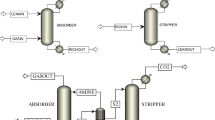Abstract
The steam reforming processes of raw coke oven gas (RCOG) for hydrogen production without and with CO2 adsorption were studied via the thermodynamic analysis. Ordinary pressure (1 bar) was found as the best reaction pressure for RCOG steam reforming. The hydrogen yield increased with the increases in temperature and S/RCOG ratio and then flatted out around 160 mol per 100 mol RCOG at the temperature above 700 °C and S/RCOG ratio above 0.8, yet with hydrogen concentration of just about 70 %. After the addition of CaO as CO2 sorbent, the hydrogen yields increased on the whole as the CaO/C ratio and S/RCOG ratio rose, and the temperature range with the hydrogen yield around 160 mol and even higher was widened and moved to low temperature. The optimal conditions of sorption-enhanced RCOG steam reforming for hydrogen production were S/RCOG ratio above 0.8, CaO/C ratio above 2.0 and the temperature from 550 to 700 °C, with the hydrogen yield and concentration reaching around 160 mol and over 90 %, respectively.













Similar content being viewed by others
Abbreviations
- RCOG:
-
Raw coke oven gas
- T:
-
Temperature of reforming reaction, °C
- S/RCOG:
-
The ratio of the additional steam mole number to the total mole number of all the components of RCOG
- CaO/C:
-
The ratio of the additional CaO mole number to the total C mole number in RCOG
References
Seth D. Hydrogen futures: toward a sustainable energy system. Int J Hydrog Energy. 2002;27:235–64.
Pena MA, Gomez JP, Fierro JLG. New catalytic routes for syngas and hydrogen production. Appl Catal A. 1996;144(1–2):7–57.
Vagia EC, Lemonidou AA. Thermodynamic analysis of hydrogen production via steam reforming of selected components of aqueous bio-oil fraction. Int J Hydrog Energy. 2007;32(2):212–23.
Koo KY, Lee JH, Jung UH, Kim SH, Yoon WL. Combined H2O and CO2 reforming of coke oven gas over Ca-promoted Ni/MgAl2O4 catalyst for direct reduced iron production. Fuel. 2015;153:303–9.
Cheng HW, Yao WL, Lu XG, Zhou ZF, Li CH, Liu JZ. Structural stability and oxygen permeability of BaCo0.7Fe0.2M0.1O3 − δ (M = Ta, Nb, Zr) ceramic membranes for producing hydrogen from coke oven gas. Fuel Process Technol. 2015;131:36–44.
Qin ZF, Ren J, Miao MQ, Li Z, Lin JY, Xie KC. The catalytic methanation of coke oven gas over Ni–Ce/Al2O3 catalysts prepared by microwave heating: effect of amorphous NiO formation. Appl Catal B. 2015;164:18–30.
Joseck F, Wang M, Wu Y. Potential energy and greenhouse gas emission effects of hydrogen production from coke oven gas in US steel mills. Int J Hydrog Energy. 2008;33:1445–54.
Shen J, Wang ZZ, Yang HW, Yao RS. A new technology for producing hydrogen and adjustable ratio syngas from coke oven gas. Energy Fuels. 2007;21:3588–92.
Kirton J, Crisp T. The analysis of organic oven emissions in coke. Fuel. 1991;70:1383–9.
Quitete CPB, Bittencourt RCP, Souza MMVM. Steam reforming of tar using toluene as a model compound with nickel catalysts supported on hexaaluminates. Appl Catal A. 2004;478:234–40.
Tao W, Cheng HW, Yao WL, Lu XG, Zhu QH, Li GS, Zhou ZF. Syngas production by CO2 reforming of coke oven gas over Ni/La2O3–ZrO2 catalysts. Int J Hydrog Energy. 2014;39(32):18650–8.
Cheng HW, Feng SH, Tao W, Lu XG, Yao WL, Li GS, Zhou ZF. Effects of noble metal-doping on Ni/La2O3–ZrO2 catalysts for dry reforming of coke oven gas. Int J Hydrog Energy. 2014;39(24):12604–12.
Shen SG, Chen PP, Li AQ, Qin HF, Li BB, Ren YP. Effect of three processes on CO2 and O2 simultaneously reforming of coke oven gas to syngas. Chem Eng Process Process Intensif. 2014;75:75–80.
Zhang JY, Zhang XH, Chen Z, Li L. Thermodynamic and kinetic model of reforming coke-oven gas with steam. Energy. 2010;35(7):3103–8.
Xie HQ, Yu QB, Duan WJ, Yao X, Li XH, Qin Q. Selection of CO2 sorbent used in bio-oil steam reforming process for hydrogen production. Environ Progress Sustain Energy. 2015;. doi:10.1002/ep.12083.
Xie HQ, Yu QB, Wang K, Shi XB, Li XH. Thermodynamic analysis of hydrogen production from model compounds of bio-oil through steam reforming. Environ Progress Sustain Energy. 2015;33(3):1008–16.
Yan CF, Cheng F, Hu RR. Hydrogen production from catalytic steam reforming of bio-oil aqueous fraction over Ni/CeO2–ZrO2 catalysts. Int J Hydrog Energy. 2010;35(21):11693–9.
Authaynun S, Wiyaratn W, Assabumrungrat S, Amornchai A. Theoretical analysis of a glycerol reforming and high-temperature PEMFC integrated system: hydrogen production and system efficiency. Fuel. 2013;105:345–52.
Ortiz AL, Harrison DP. Hydrogen production using sorption-enhanced reaction. Ind Eng Chem Res. 2001;40(23):5102–9.
Hanaoka T, Yoshida T, Fujimoto S, Kamei K, Harada M, Suzuki Y, Hatano H, Yokoyama S, Minowa T. Hydrogen production from woody biomass by steam gasification using a CO2 sorbent. Biomass Bioenergy. 2005;28:63–8.
Xie HQ, Yu QB, Wei MQ, Duan WJ, Yao X, Qin Q, Zuo Z. Hydrogen production from steam reforming of simulated bio-oil over Ce–Ni/Co catalyst with in continuous CO2 capture. Int J Hydrog Energy. 2015;40:1420–8.
Xie HQ, Yu QB, Yao X, Duan WJ, Yao X, Zuo Z, Qin Q. Hydrogen production via steam reforming of bio-oil model compounds over supported nickel catalysts. J Energy Chem. 2015;24(3):299–308.
Simell PA, Hepola JO, Krause AOI. Effects of gasification gas components on tar and ammonia decomposition over hot gas cleanup catalysts. Fuel. 1997;76(12):1117–27.
Nunnally T, Tsangaris A, Rabinovich A, Nirenberg G, Chernets I, Fridman A. Gliding arc plasma oxidative steam reforming of a simulated syngas containing naphthalene and toluene. Int J Hydrog Energy. 2014;39:11976–89.
Yan CF, Hu EY, Cai CL. Hydrogen production from bio-oil aqueous fraction with in situ carbon dioxide capture. Int J Hydrog Energy. 2010;35:2612–6.
Comas J, Laborde M, Amadeo N. Thermodynamic analysis of hydrogen production from ethanol using CaO as a CO2 sorbent. J Power Sources. 2004;138(1–2):61–7.
Kinoshita CM, Turn SQ. Production of hydrogen from bio-oil using CaO as a CO2 sorbent. Int J Hydrog Energy. 2003;28(10):1065–71.
Martavaltzi CS, Lemonidou AA. Development of new CaO based sorbent materials for CO2 removal at high temperature. Microporous Mesoporous Mater. 2008;110:119–27.
Mahishi MR, Goswami DY. An experimental study of hydrogen production by gasification of biomass in the presence of a CO2 sorbent. Int J Hydrog Energy. 2007;32:2803–8.
Duan WJ, Yu QB, Xie HQ, Qin Q, Zuo Z. Thermodynamic analysis of hydrogen-rich gas generation from coal/steam gasification using blast furnace slag as heat carrier. Int J Hydrog Energy. 2014;39:11611–9.
Wang K, Yu QB, Duan WJ, Qin Q, Xie HQ. The adaptability of Cu/Zr oxides as oxygen carrier used for chemical looping air separation (CLAS). J Therm Anal Calorim. 2014;115(2):1163–72.
Wang K, Yu QB, Qin Q. The thermodynamic method for selecting oxygen carriers used for chemical looping air separation. J Therm Anal Calorim. 2013;112(2):747–53.
Acknowledgements
This research was financially supported by the National Natural Science Foundation of China (51576035), the National Key Technology R&D Program of China (2013BAA03B03), the Fundamental Research Funds for the Central Universities (N150203006) and the National Science Foundation for Post-doctoral Scientists of China (2015M571322).
Author information
Authors and Affiliations
Corresponding authors
Rights and permissions
About this article
Cite this article
Xie, H., Yu, Q., Zuo, Z. et al. Thermodynamic analysis of hydrogen production from raw coke oven gas via steam reforming. J Therm Anal Calorim 126, 1621–1631 (2016). https://doi.org/10.1007/s10973-016-5638-9
Received:
Accepted:
Published:
Issue Date:
DOI: https://doi.org/10.1007/s10973-016-5638-9




